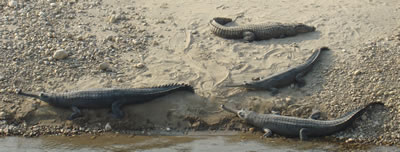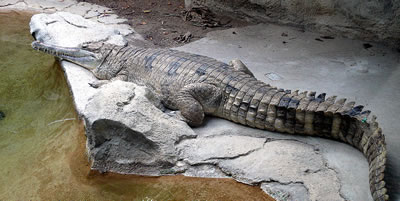Gharials and False Gharials

Facts about creatures
- Home
- Animal Classification
- Animal Habitats
- Amphibians
- Arthropods
- Bats
- Birds
- Carnivorans
- Cetaceans
- Chordates
- Crustaceans
- Dinosaurs
- Diprotodonts
- Elephants
- Fish
- Golden Mole
- Insects
- Lagomorphs
- Mammals
- Mammal Teeth
- Marsupial Mole
- Metamorphosis
- Mollusks
- Primates
- Reptiles
- Rodents
- Ruminants
- Soricomorphans
- Tenrec
- Tetrapods
- Vertebrates
Gharials and False Gharials
Gharials (also known as gavials) and false gharials (also known as false gavials) are the two living members of the family Gavialidae. They are crocodilians.
Gharials and false gharials have snouts that are much thinner than the snouts of other crocodilians.
Gharial
The gharial (Gavialis gangeticus) is sometimes called the gavial, the Indian gharial, or the Indian gavial.

It can be found in northern India and Nepal, in deep, quickly flowing rivers with sandy banks.
A gharial has a long, flat snout that looks something like a duck’s bill and contains many sharp, needle-like, interlocking teeth. The snout grows longer and thinner as the gharial grows older.
The diet of an adult gharial consists almost exclusively of fish. The gharial catches fish by sweeping its long, thin snout side by side in the water. Fish become trapped between the gharial’s interlocking teeth, where they are held tightly in place. Because the gharial’s snout is so thin, it can move back and forth in the water with little resistance.
Occasionally, gharials will eat crustaceans, snakes, frogs, birds and small mammals.
Juvenile gharials eat insects and small frogs.
Some gharials have been found with jewelry in their stomachs. This once led people to believe that gharials ate human beings. However, it is now thought that gharials take jewelry from cremated human bodies that are left floating down rivers as part of a Hindi funeral ritual. The gharials use the jewelry as gastroliths to help them digest food.
A gharial’s jaws are too small and weak for it to be able to eat a human or other large mammal.
Gharials are long, slender reptiles. They usually range from about 12 feet to about 16 feet long, but can grow even longer, possibly to more than 20 feet long. They are comparable in length to saltwater crocodiles, the largest crocodilian species, although they are not as heavy as saltwater crocodiles.
An adult gharial is dark olive or gray on top, with a pale yellow underside. Young gharials are lighter colored and have dark spots and bands.
Gharials move through water very easily. They have fully webbed hind feet and large, flat tails that act like oars. However, they are not very agile on land. Gharials have stumpy legs and can’t lift their bodies off the ground completely. They move along land by sliding their bellies along the ground.
A gharial will spend more time in the water than other crocodilians. Gharials only leave the water to bask in the sun or to nest.
An adult male gharial has a bulb-like growth, known as a ghara at the end of his snout. It is used to attract females. The male will use his ghara to blow bubbles during courtship. The ghara makes a buzzing noise when he exhales through it. It is believed that the male makes this noise to intimidate rivals.
Female gharials lay eggs in holes that they dig in sandy riverbanks. There are usually between 30 and 50 eggs in a clutch.
Gharial eggs are larger than those of any other species of crocodilian. The average gharial egg weighs about six ounces.
A female gharial will guard her eggs and will guard her young after they hatch. However, unlike other crocodilians, she will not lift her newly-hatched young into her mouth and carry them into the water.
This may be because her jaws are too small or because her sharp teeth would hurt the baby gharials.
Gharials are a critically endangered species as a result of hunting and habitat destruction. Some people kill male gharials for their snouts, which are supposed to be aphrodisiacs. Gharial eggs are sometimes used in folk medicine.
False Gharial
The false gharial (Tomistoma schlegelii), which is sometimes called the false gavial, Malayan gharial or Malayan gavial, lives in rivers, lakes and swamps in Malaysia and Indonesia.
False gharials can range in size from 13 feet to more than 16 feet long.
They are green or brown with dark bands and creamy white bellies. Juveniles and adults have similar coloring.

The false gharial has a long, thin snout, like the true gharial. However, the false gharial’s snout is shorter and wider than the true gharial’s snout.
The false gharial has a more varied diet than the true gharial. The false gharial’s snout is wide enough and strong enough for it to eat birds, reptiles and mammals, as well as fish and crustaceans. False gharials can eat large mammals, such as macaque monkeys. There are reports of false gharials eating deer.
A female false gharial will lay her eggs in a mound nest that she builds out of plant matter. She will abandon the nest after she lays her eggs. Because the young receive no parental care, many of them are quickly killed by predators, such as wild pigs.
The false gharial is an endangered species.